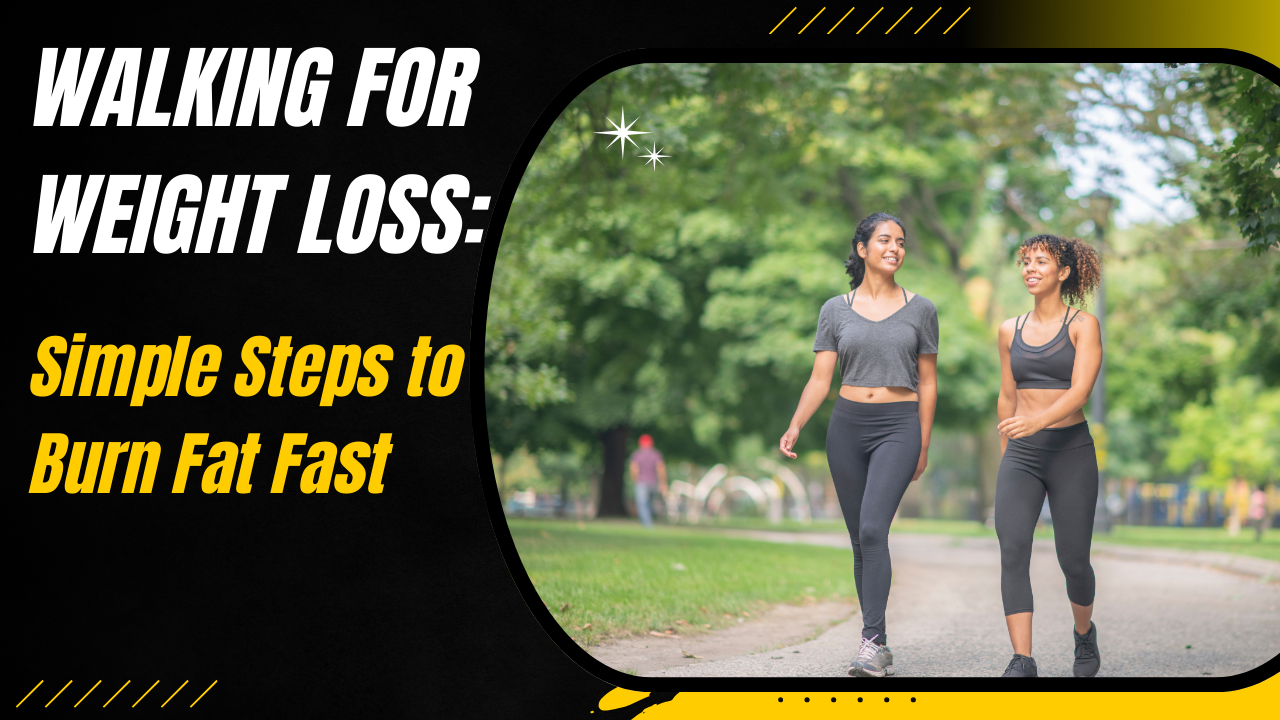Walking is one of the simplest and most effective ways to lose weight and improve overall health. A consistent walking for weight loss routine can help burn calories, boost metabolism, and strengthen muscles without requiring intense workouts or gym equipment. Unlike other exercises, walking is low-impact, making it suitable for all age groups and fitness levels.
In a walking for weight loss plan, the focus is not just on moving but on walking with the right intensity, duration, and frequency. Combining walking with proper nutrition enhances fat burning and supports a healthy lifestyle. Regular walking also improves cardiovascular health, balances blood sugar levels, and reduces stress.
By adopting a structured walking for weight loss approach, individuals can gradually shed excess pounds while promoting overall well-being. This guide outlines the top 8 tips, benefits, and practical strategies to maximize weight loss through walking, making it a sustainable part of daily life.

What is Walking for Weight Loss?
Walking for weight loss is a form of low-impact cardiovascular exercise that helps burn calories, reduce body fat, and improve overall health. It involves moving at a pace that elevates your heart rate, from casual strolling to brisk walking, depending on fitness levels. Unlike high-intensity workouts, walking is gentle on joints and suitable for all ages, making it an ideal activity for beginners and advanced fitness enthusiasts alike.
In a walking for weight loss routine, consistency is key. Walking daily or several times a week, combined with proper diet, allows your body to maintain a calorie deficit while preserving muscle mass. This approach supports gradual and sustainable fat loss without extreme restrictions.
Additionally, walking for weight loss offers mental and emotional benefits. Walking outdoors reduces stress, improves mood, and enhances mental clarity, making it not just a weight loss tool but a holistic approach to better well-being.
Why Walking for Weight Loss is Effective
Walking for weight loss is effective because it combines calorie burning with low injury risk, making it sustainable over the long term. Even moderate walking sessions increase metabolism, improve cardiovascular function, and strengthen muscles, which collectively contribute to fat loss.
Regular walking stimulates fat metabolism while supporting joint health. Unlike strenuous workouts that may cause fatigue or injury, walking is gentle yet efficient, making it easier to adhere to a walking for weight loss routine consistently.
Moreover, walking helps regulate appetite, improve digestion, and stabilize blood sugar levels. A consistent walking for weight loss plan also encourages healthier lifestyle habits, such as better sleep, improved hydration, and mindful eating, all of which amplify fat-burning results.
When to Walk for Weight Loss
Timing plays a role in maximizing the benefits of walking for weight loss. Walking in the morning on an empty stomach can help burn stored fat, while post-meal walks aid digestion and prevent excessive fat accumulation.
Consistency is more important than exact timing. Daily walking sessions, even split into 15–30 minute intervals, maintain metabolism and energy levels throughout the day. A structured walking for weight loss schedule helps establish a routine that your body adapts to, increasing calorie burn efficiency.
Even short walks during breaks or after work contribute to a walking for weight loss plan. The key is to remain consistent, gradually increasing intensity, pace, or duration as your stamina improves, ensuring sustainable fat loss and overall health benefits.
How Does Walking for Weight Loss Work?
Walking for weight loss works by creating a calorie deficit where your body burns more energy than it consumes. Brisk walking elevates heart rate, mobilizes stored fat, and strengthens muscles, increasing overall calorie expenditure.
Interval walking or walking on inclines further boosts metabolism and accelerates fat loss. When combined with a balanced diet, walking for weight loss ensures that calories burned are sufficient for sustainable weight reduction without compromising energy or muscle mass.
Additionally, walking improves circulation, oxygen delivery, and hormonal balance, all of which support effective fat metabolism. By maintaining a regular walking for weight loss routine, the body adapts to increased activity levels, gradually reducing fat stores and promoting a toned, healthier physique.
Top Tips for Walking for Weight Loss
Walk Briskly for Maximum Fat Burn
Brisk walking is one of the most effective strategies in a walking for weight loss plan. By increasing your pace to a moderate-to-fast level, you elevate your heart rate, which in turn burns more calories and stimulates fat metabolism. Unlike casual walking, brisk walking helps your body utilize fat as a primary energy source, making it a powerful tool for gradual and sustainable weight loss. Incorporating brisk walking into your daily routine ensures that your sessions are productive and contribute directly to shedding excess pounds while improving cardiovascular health.
To further enhance the benefits of walking for weight loss, you can alternate between brisk walking and slower recovery paces. This interval approach increases metabolism and allows your body to continue burning calories even after the walk is completed. It also strengthens muscles in your legs, core, and glutes, giving you a toned lower body and improved endurance over time. The combination of elevated heart rate and sustained activity turns simple walking into a highly effective fat-burning exercise.
Consistency is crucial in a walking for weight loss routine. Aim to walk briskly for at least 30–60 minutes daily, adjusting pace and duration according to your fitness level. Using tools like fitness trackers or smartphone apps to monitor distance, speed, and heart rate can keep you accountable and motivated. Ensuring proper footwear and hydration also helps prevent injuries and enhances comfort. By making brisk walking a regular habit, you can steadily achieve your weight loss goals while enjoying improved overall health.
Benefits: Burns more calories, strengthens lower body, improves heart health.
Ingredients/Tools: Comfortable walking shoes, fitness tracker, water bottle.
Incorporate Interval Walking

Interval walking is a highly effective approach in a walking for weight loss plan. It involves alternating between periods of brisk walking and slower recovery pace, which challenges your cardiovascular system while keeping workouts dynamic. Unlike steady-paced walking, interval sessions increase calorie burn both during and after your walk by boosting metabolism. This method also keeps your body adapting, preventing plateaus and promoting consistent fat loss over time.
Studies show that interval walking can target stubborn fat more efficiently than uniform walking sessions. By introducing short bursts of high-intensity walking, you engage additional muscles and elevate your heart rate, which enhances endurance and strengthens your lower body. Incorporating intervals into a walking for weight loss routine ensures that workouts remain challenging yet sustainable, making it easier to stick to your weight loss goals.
To implement interval walking, alternate 1–2 minutes of brisk walking with 2–3 minutes of moderate walking. Gradually increase intensity as your fitness improves, ensuring your walking for weight loss plan progresses safely. Using a stopwatch or fitness tracker can help you monitor intervals and track improvements. Over time, interval walking becomes a fun, efficient, and highly effective method to maximize fat burning.
Benefits: Accelerates calorie burn, improves endurance, targets fat loss.
Ingredients/Tools: Stopwatch, comfortable shoes, open walking path or treadmill.
Maintain Proper Walking Posture
Maintaining proper posture is essential in a walking for weight loss plan because it maximizes calorie burn and engages the correct muscles. Standing tall with shoulders relaxed, head held high, and engaging the core ensures that your movements are efficient. Swinging your arms naturally while walking not only improves balance but also increases upper-body involvement, turning a simple walk into a more comprehensive workout that enhances fat-burning potential.
Correct posture also reduces the risk of injuries, such as joint strain or back pain, which can disrupt your walking for weight loss routine. By focusing on posture, you strengthen core muscles, tone your abdomen, and improve coordination. Over time, walking with proper form can enhance your overall gait and stability, making every step more effective for weight loss and general fitness.
To make posture a habit, periodically check your alignment during walks, whether on a treadmill or outdoors. Pair proper posture with consistent pace and duration in your walking for weight loss plan for maximum results. Comfortable shoes, supportive socks, and an open walking space further ensure that your walks remain safe, enjoyable, and highly effective for fat burning.
Benefits: Reduces injury risk, tones
Track Your Steps and Progress
Tracking steps is an essential strategy in any walking for weight loss plan. Monitoring your daily activity using pedometers, fitness apps, or smartwatches helps you stay accountable and ensures that you consistently meet your weight loss goals. By tracking progress, you gain a clear picture of how far you’ve come and can identify areas for improvement, which keeps motivation high.
Aim for a minimum of 10,000 steps per day and gradually increase your target as endurance improves. Regular monitoring encourages adherence to your walking for weight loss routine and helps maintain a calorie deficit, which is critical for fat loss. Tracking also allows you to evaluate patterns, such as the best time of day for your walks or days when your activity may lag.
Analyzing data over time helps you adjust intensity, duration, and pace to maximize results. Pairing step tracking with diet monitoring creates a comprehensive walking for weight loss plan that promotes sustainable fat loss, better fitness, and overall health. Tools like fitness trackers and smartphone apps make this process simple and convenient, turning every walk into measurable progress.
Benefits: Increases motivation, measures progress, enhances consistency.
Ingredients/Tools: Fitness tracker, pedometer, smartphone apps.
Walk After Meals

Walking after meals is a simple yet highly effective strategy in a walking for weight loss plan. A short 15–30 minute walk following breakfast, lunch, or dinner helps stimulate metabolism, aiding digestion and preventing excess fat storage. This gentle activity encourages your body to use calories efficiently, turning an everyday habit into a practical fat-burning routine.
Post-meal walking also stabilizes blood sugar levels and improves insulin sensitivity, which is especially important for long-term weight management. By incorporating these walks into your walking for weight loss plan, you not only enhance fat burning but also reduce bloating and discomfort after eating. Over time, consistent post-meal walks become a sustainable and easy-to-follow habit that complements a healthy diet.
For optimal results, choose comfortable shoes and a safe walking area, and maintain a brisk yet manageable pace. Pair this routine with hydration and proper posture to maximize the benefits of your walking for weight loss plan. Simple tools like a water bottle or fitness tracker can help you stay motivated and track progress.
Benefits: Improves digestion, prevents fat accumulation, stabilizes blood sugar.
Ingredients/Tools: Comfortable shoes, open walking area, optional water bottle.
Use Inclines or Hills
Walking on inclines or hills is an advanced technique in a walking for weight loss plan that intensifies workouts and engages more muscles. Uphill walking elevates your heart rate, strengthens your legs, glutes, and core, and increases overall calorie expenditure compared to walking on flat surfaces. Adding inclines introduces variety, which helps prevent workout monotony and keeps your body challenged.
Incorporating hills or treadmill inclines into your walking for weight loss routine improves endurance and accelerates fat loss. The added resistance forces your body to work harder, enhancing cardiovascular health while building lower-body strength. It also helps tone muscles, leading to a firmer and more sculpted physique over time.
Start with gentle slopes and gradually increase the incline and duration as your fitness improves. Combining incline walks with flat walks creates a balanced walking for weight loss plan that is sustainable, effective, and enjoyable. Supportive shoes and a safe walking path or treadmill are essential to maximize performance and prevent injury.
Benefits: Burns more calories, tones lower body, enhances endurance.
Ingredients/Tools: Inclined walking path or treadmill, supportive shoes.
Combine Walking with Strength Training

Combining walking with strength training enhances the effectiveness of a walking for weight loss plan by building lean muscle, which boosts metabolism and increases calorie burn even at rest. Strength training complements walking by targeting major muscle groups, improving body composition, and supporting fat loss more efficiently than walking alone.
Incorporating light weights or resistance exercises on alternate days of your walking for weight loss routine intensifies workouts and engages multiple muscles. Using dumbbells, resistance bands, or bodyweight exercises helps sculpt the upper and lower body while improving posture, balance, and overall strength. This combination ensures a holistic approach to fitness, maximizing both fat loss and muscle tone.
For best results, alternate between walking sessions and strength workouts, or add light resistance during your walks. This integrated approach keeps your walking for weight loss plan dynamic, challenging, and sustainable. Proper footwear, workout space, and accessible equipment make it safe and enjoyable while accelerating long-term results.
Benefits: Builds lean muscle, increases calorie burn, improves body composition.
Ingredients/Tools: Dumbbells, resistance bands, gym or home space, walking shoes.
Stay Consistent and Motivated
Consistency is the key to success in any walking for weight loss plan. Regular walking, even for shorter sessions, is far more effective than occasional long walks. Maintaining a routine helps your body adapt, improves endurance, boosts metabolism, and ensures sustainable fat loss over time. Consistency also reinforces healthy habits, making walking a natural part of your lifestyle.
Motivation plays a crucial role in sticking to a walking for weight loss routine. Setting realistic goals, joining walking groups, or listening to music and podcasts can make your walks enjoyable and engaging. Celebrating small milestones, tracking progress, and rewarding achievements helps maintain commitment and prevents discouragement, ensuring that your weight loss journey stays on track.
Pairing consistency with proper diet, hydration, and adequate rest amplifies the effectiveness of your walking for weight loss plan. Using tools like fitness trackers, motivational playlists, or step challenges keeps you accountable and inspired, helping you reach your fat loss goals while improving cardiovascular health, stamina, and overall well-being.
Benefits: Ensures sustainable weight loss, builds endurance, improves cardiovascular health.
Ingredients/Tools: Walking shoes, fitness tracker, motivational playlists.
Conclusion

Walking is an accessible, low-impact, and highly effective method for losing weight. A structured walking for weight loss plan not only burns calories but also improves cardiovascular health, strengthens muscles, and enhances mental well-being. By combining consistent walking with proper nutrition, hydration, and lifestyle habits, individuals can achieve sustainable fat loss.
Incorporating strategies such as brisk walking, interval training, incline walking, and post-meal walks maximizes calorie burn and accelerates weight loss. Tracking steps, maintaining proper posture, and combining walking with strength exercises further enhances the effectiveness of a walking for weight loss routine.
Ultimately, a successful walking for weight loss plan relies on consistency, motivation, and a balanced approach. By adopting these tips, anyone can make walking a daily habit that promotes fat loss, boosts energy, and improves overall health naturally. Sustainable results are achievable with dedication and mindful implementation of these strategies.
FAQs
1. How long should I walk daily for weight loss?
Aim for 30–60 minutes daily. A consistent walking for weight loss routine ensures calorie burn and promotes fat loss.
2. Can walking alone help me lose weight?
Yes, walking contributes significantly to weight loss. For best results, combine walking with healthy nutrition in a structured walking for weight loss plan.
3. What is the best time to walk for fat loss?
Morning or post-meal walks are ideal. Timing enhances metabolism and ensures the walking for weight loss routine is effective.
4. Should I walk fast or slow for weight loss?
Brisk walking is more effective. Interval walking also boosts calorie burn in a walking for weight loss plan.
5. Can walking help tone muscles?
Yes, regular walking, especially with inclines, tones legs, glutes, and core as part of a walking for weight loss strategy.
